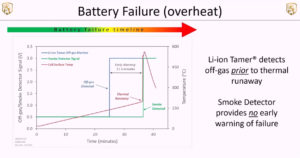
Lithium-ion batteries are a hazard. Like a lion, their temperament can change at a moment’s notice, leaving them to ignite in a single cell, engulf an entire building in flames, explode a whole worksite and injure people at every step of the way.
The risks are known, but you can (and are required by NFPA 855 to) take steps to monitor your Battery Energy Storage Solutions (BESS) before it goes that far.
Don’t poke the beast while waiting for an incident to take place before you start monitoring. Act now and tame your operation with the Li-ion Tamer before people get hurt or you’re forced to shut down as a result of a catastrophic event.
See the Warning Signs Before It’s Too Late
Knowing how to detect and alert you of an unstable battery starts with understanding how batteries fail. There are four steps that indicate a failure. Honeywell/Nexceris’ Li-ion Tamer [link to product page] is the only product that can detect failure before steps 3 & 4 where smoke and fire occur when there’s no retreat.
Stage 1 – Initial abuse – can be thermal or electrical abuse such as physical battery damage, overcharging, overheating, and manufacturing defects.
Stage 2 – Off-gas generation – the pre-indicator for a fire when it can still be prevented—this is where the Li-ion Tamer detects the failure and notifies you. From here, you have approximately 10 minutes to shut the battery down.
Stage 3 – Smoke generation – at this point, thermal runaway has occurred and a catastrophic event is imminent.
Stage 4 – Fire generation – propagation begins—the failed battery can force other surrounding batteries to go through the same cycle.
Once smoke and fire have started, it’s too late to prevent further propagation This is where inferior products and technologies notify you of an imminent failure. They might allow you to reduce the impact (if you’re lucky) but not stop it altogether.
To give yourself more time to see the signs and prevent a fire,
Check out Li-ion Tamer by Honeywell & Nexceris.
The Power of the Li-ion Tamer
Most BESSs are like a Russian Nesting Doll. There’s a hard- or soft-cased battery inside a module, inside a stack, inside a room—and with 10,000+ batteries, if one goes, they all rapidly become a hazard to anything and anyone in the vicinity.
Li-ion Tamer sensors are placed inside each of the racks—these monitoring sensors will sense off-gasses, send a signal to a controller that indicates battery failure and prevent further damage and propagation. The sensors are free of electrical or mechanical contact with the cell and, as such, they are easy to install and can be added to existing storage systems.
In addition to the rack sensors, there are reference sensors strategically placed throughout the ambient environment to prevent false alarms. These reference sensors ensure rapid detection while reducing false alarms.
Li-ion Tamer has a record of 0 fires and 0 false positives.
The sensors are calibration-free as they report a sharp deviation from the baseline, not the quantity of gas. They are auto-fault indication and will notify you if any sensors enter an error state. And, most impressively, they outlast the lithium-ion batteries themselves with a 15+ year lifetime.
For a full product presentation watch:
Or to see how Li-ion Tamer could integrate with your system,
The Industries We Serve
After eight years of extensive research and development in conjunction with the U.S. Navy, this one-of-a-kind product is surging in these industries:
- Renewables (solar and wind) storage
- Marine
- Aviation
- Shipping and storage
- Laboratory safety
- Automotive
Protect Your Operation & Reputation
Are you ready to make your operation compliant with NFPA 855? One phone call can tame wild and unstable lithium-ion batteries, so you can remain unruffled knowing your people, operations and reputation are protected.
See how the Li-ion Tamer could integrate with your system,
Learn more about the Li-ion Tamer,

